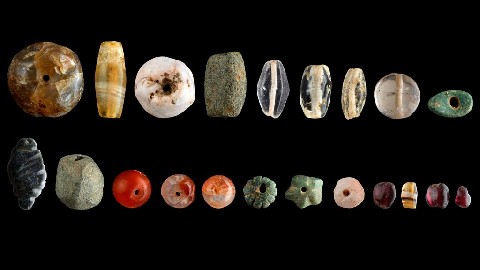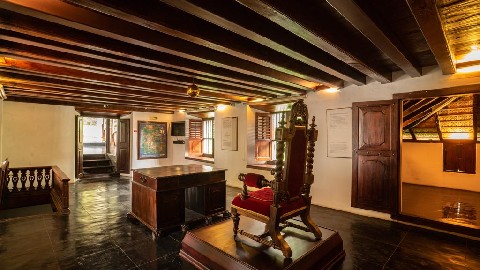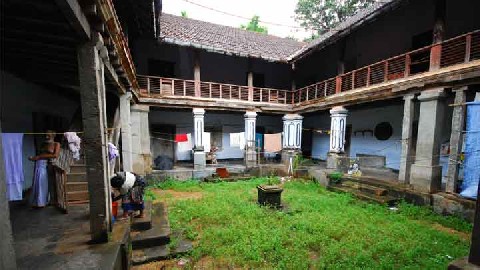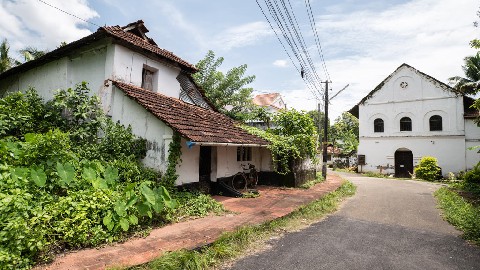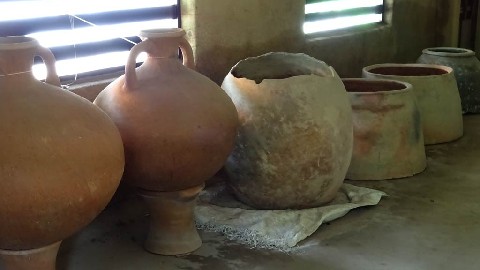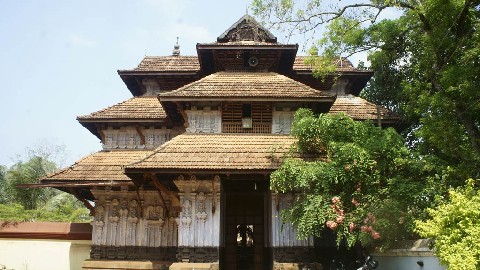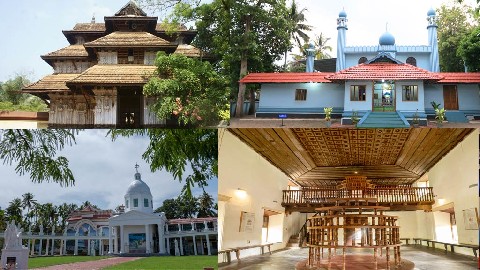History
Muziris was an active port on the west coast of southern India in the 1st century BCE. Through many centuries, it became the region’s window to the world of different cultures, religions, and levels of development. Simultaneously, it was a welcoming port of call for travellers, who would later be followed by traders, evangelists and colonizers. It had its heydays when the place buzzed with activity, when businesses flourished, when new religions rubbed shoulders with the old, and new political powers sought to impose themselves on the existing ones. Perhaps the region reached its acme of prosperity when the merchants of Muziris established Indo-Greek and Indo-Roman-Egyptian trade with the Jews, the Arabs, the Portuguese, the Dutch, the Chinese, the British, and many others.
Although archaeologists and historians have still not discovered when the city port was actually established, they are unanimous in their belief that Muziris was the headquarters of the early Chera dynasty. Viewed from the present times, Muziris earns another significance. It has the privilege of being a major signboard because its genesis marked the beginning of recorded history of the land of Kerala.
The Name
There is a kaleidoscopic variety to the word "Muziris" that lends it an ever-changing dimension of beauty, and mesmerizes the modern history-enthusiast. More significantly, the different names give a peek into the varied perspectives that our ancestors, native and foreign, adopted to look at the same land and the riches it offered. According to one version, the original name was derived from a Sanskrit word Maareecham which means "a clump of pepper vines". Indeed, the land on the west coast of southern India was so rich in this exotic spice that its fame spread far and wide, and men from faraway lands were prepared to brave long and treacherous sea voyages, and trade gold in order to purchase it. Little wonder that pepper came to be known in local parlance as karuthaponnu [black gold]! According to another version, it was originally "Muchiri pattanam" (muchiri means "cleft palate" and pattanam means "town"). The name referred to a port town that was located in a fork/cleft in Periyar river. The pronunciation of the Greeks and other Westerners who came to the port on business changed it to "Muziris".
To the ancient Egyptians it was 'Machiri pattanam,' Mesori being the month they began their journey in, so as to take advantage of the monsoon winds for a safe and quick passage to the Arabian Sea. Variations of the name included "Mucirri", "Musiri", "Murachipattanam", "Marichipattanam", "Muzirikode", "Makothaipattanam", "Mahodayapattanam" and so on. In the Jewish Copper Plate of Bhaskara Ravi Varman (1000 CE) it is "Muyirikode". To the Arabs, the place was "Cyngilin" (derived from the Sanskrit word Shringhala meaning chain, as the goods were transported through a chain of canals from the sea to the hinterlands of Kerala).
However, tragedy struck in 1341 when the course of the Periyar underwent a major change, causing floods and earthquake. The result was that Muziris dropped off the trade map of the world. In his account of his voyages, Niccolo de Conti, the 15th century Italian merchant and explorer, makes a mention of the place, and in the 16th century it came to be known as Cranganore. Today, Muziris is known as Kodungallur, and is situated in Thrissur district in central Kerala.
The Political History of Muziris
The records of Pliny (1st century CE) suggest that Thondi and Muziris were under the rule of Keralaputras, who were the Cheras of Karur. From them, it would appear that the Cheras took possession of the West coast much later. This view is supported by the statement that Musiri was at that time attacked by the pirates of Nitrias. Nitrias of Pliny and Nitran of Ptolemy is the modern port of Mangalapuram (Mangaluru of today), on the mouth of river Netravati. It was the principal port of Thondi and Musiri until the Cheras took possession of it in the first century. Sangham poetry further supports this view.
The battles for ocean supremacy continued for centuries. The Cheras established outposts at Kodungallur and Thondi, and made them a province of the Chera country called Kudanadu, which meant the Western province. Later, Kodungallur became the capital of Kudanadu from where the Chera princes ruled until the end of the 12th century.
The Perumals
Sthanu Ravi was the first Perumal to be installed at Thirunavai in 887 CE. He and many of his successors were Cheras. His reign cannot have been earlier than the last quarter of the 9th century.
Bhaskara Ravi Varman I who is said to have issued a Jewish copper plate from Musiri to Joseph Rabban the Jew, was not a resident of that place. It is clearly stated in the document that he was only camping there when he issued the document.
Mushikas and Venadu kings were subservient to Karnataka and Pandya rulers respectively. The central region of Malainadu, viz., Kerala, continued as a province of the Chera kingdom. Hence Malainadu got the name Kerala and the institution of Perumal came to be known as Kerala Perumal.
As Eastern Cheras were vassals of Karnataka, they were known as Kongu Cheras and that part of the Chera country came to be known as Kongunadu. This region which was the hinterland of Musiri, and Thondi helped in the growth of the two port cities. With the loss of that territory, the primacy of Musiri was lost and Thondi faded into oblivion.
The Palace of the Perumals
Cheraman Parambu is an important site included in the Muziris Heritage Project. During the time when the Cheras ruled over Kerala, they set up their palace at Cheraman Parambu in their capital of Kodungallur. Today it wears a deserted look, a far cry from a bustling centre it must have been in the ancient times. It is hard to believe that this nondescript stretch of land that has suffered years of neglect was once a busy hub, thrumming with all kinds of human activity.
A reference to this palace can be found in a work titled Laghu Bhaskareeya Vyakhya written at around 870 CE. The work features a conversation between its author Sankara Narayana the poet and the Perumal of that time named Sthanu Ravi. The splendour of the place – reflected in the capital city, its streets, palatial buildings, royal residences and so on - finds special mention in it. The prosperous and majestic area was also known as Gotramalleswaram during that time. To the north of the palace was a temple known as Balakreedeshwaram, dedicated to Lord Ganapati. And close to it stood an observatory and certain yantras, which were used to tell the time, and view the stars.
A title deed inscribed in copper plates (known as Veeraraghava pattayam) created in the 13th century indicates that the capital of the Chera Perumals was known by the name Perum kovilakam [the big palace]. But by the time Kokasandesham, a 14th century work of Tamil literature, was composed, the scenario had changed beyond recognition. The poem describes Kodungallur as a place that once rivalled the heavens in prosperity. By then, the fortune of the Perumals was on the decline, and the star of Cochin royal family was on the ascendant.
Today, excavated remnants of gigantic walls, iron and copper nails, hooks and pillars bearing sculpted figures are all that exist to remind us of a period of glory and greatness that Kodungallur once enjoyed. Those palaces, palatial buildings, store houses, shops and markets have been washed away by the flood waters of time. What was once the capital city of the Perumals has dwindled into a waste land, overrun by weeds. It is only the signboard put up by the archaeological department of the state that gives the passing visitor a glimpse into the past – the story of a city that it was once a dynamic administrative centre during a glittering phase of the history of Kerala.
The Paliam Family in Muziris History
The history of the Paliam family should be read along with the history of Kerala. During the period following the break-up of the Kulasekhara empire in 1102 CE, Kerala lost its political unity. A number of independent swaroopams [dynasties] rose in different parts of the land.
The Perumpadappu Swaroopam had its seat at Chitrakutam in the Perumpadappu village in Vanneri, Malappuram till the end of the 13th century. But its chief had a palace of his own at Mahodayapuram in Thrissur.
When the Zamorin of Calicut invaded Valluvanad in the latter half of the 13th century, the Perumpadappu Swaroopam abandoned the Vanneri palace and shifted to Mahodayapuram on a permanent basis. The state continued to have its capital at Mahodayapuram till about 1405 when it was transferred to Cochin. Cochin had relations with Paliam from an earlier period. Along with Perumpadappu chief, Paliath Achan also started living in Thiruvanchikulam.
Paliath Achans [patriarchs the Paliam family] held the position of Prime Minister in erstwhile Cochin state in Kerala for more than 150 years. The title Achan was handed down through generations to the eldest male members of the family. They enjoyed tremendous political clout and played a decisive role in the fortunes of the princely state. And for the same reason, Paliam holds a significant position in the Muziris Heritage Project.
The Paliam family had three eminent Achans – Komi Achan I, Komi Achan II and Govindan Achan – who were the most remarkable figures in the history of Cochin. Komi Achan I is supposed to have gone to Colombo to seek help from the Dutch and signed a treaty with them, thus setting the scene for a long Paliam-Dutch friendship. Komi Achan II was a daring adventurer who mastered many languages and the use of weapons. Govindan Achan, well known as Govindan Valiachan, was the last to hold the office of the Prime Minister. It was he who retrieved the lost painting of the Virgin Mary and permitted the islanders to install it at Vallarpadam Church in Cochin. The practice of keeping alight the Kedavilakku [eternal lamp] donated by Achan to the Vallarpadam church with oil taken from Paliam, continued until recently.
Kodungallur Kovilakam
The rule of the Perumals lasted from the 9th to the 12th century CE. Following the decline of their power, many power centres sprung up. Each claimed to derive their exalted status from the erstwhile rulers and set themselves up as swaroopams. The swaroopam that ruled over the Kodungallur region was the Padinjattedathu swaroopam. Their headquarters came to be known as Kodungallur Kovilakam [royal quarters].
Kodungallur Gurukulam – An Ancient University
The Kodungallur Kovilakam was unique in that it patronized learning as well as the arts, and continued to do so till the last years of the 19th century. It became famous as Kodungallur Gurukulam and even produced a new school of poetry. The Kodungallur Gurukulam was an inexhaustible mine of knowledge, which could very well be called the first university of Kerala. Scholars like Vidwan Kunjirama Varma, Kochunni Thampuran and Kunjan Thampuran were among the teachers who gave training here.
Kodungallur Kovilakam was known as the ‘Nalanda of Kerala,’ an abode of preceptors, and followed a great tradition of imparting knowledge in different topics like grammar, literature, rhetoric, sculpture, astrology, Vedanta and the physical sciences. Separate buildings called the Old Bungalow, the New Bungalow, the Eastern Bungalow and so on were set apart for the pursuit of learning. Those who were denied entry into the royal buildings were given free accommodation in the outhouses.
Students at the Gurukulam were free to choose the subjects of their liking. They remained in one class for a year during which they studied a single book. When they graduated to the next, a different text had to be mastered. Active teaching lasted only one-and-a-half to two hours each day. The rest of the time was used for rote learning, discussions, criticism, clearing of doubts and so on. If anyone found any subject too difficult, they had the freedom to choose another. Serious extra-curricular activities like Aksharashlokam [reciting of poems, according to certain pre-set rules] and enactment of plays were encouraged. Such was the generosity of the Kovilakam that each student was given free meals twice a day, four thorths [unstitched dhoti tied at the waist and reaching up to the knees] to wear, and a mat to sleep on. This atmosphere was conducive to genuine learning and deep scholarship.
The most towering figure among the poets of the Kodungallur Kovilakam was Kunjikuttan Thampuran, one of the best and most talented writers of Malayalam literature. Kodungallur Kovilakam produced many promising talents who left their imprint in the literary history of Kerala. In those days, as poets had a deep association with the Kovilakam, and it was known under the label ‘Kodungallur Kalari’ [training centre].
Kodungallur was known for its tradition of sharing knowledge from the time of Kodungallur Vidwan Ilaya Thampuran (1800-1851). His disciple Kumbakonam Krishna Sastrigal later became a great grammarian. Valiya Thampuran and Ilaya Thampuran were experts in Astrology. Goda Varma Thampuran was another famous member of the Kovilakam. Vidwan Kunjirama Varma Thampuran (1850 – 1917) was a poet and grammarian.
Kochunni Thampuran was an exponent in astrology and architecture, and Kunjan Thampuran was an expert in dialectics. Cheriya Kochunni Thampuran was a poet and Bhatta Sree Goda Varma Thampuran, an expert in legal science. All these members kept alive the glory of Kodungallur Kovilakam.
Muziris in Mythology and Ancient Literature
Muziris features in the ancient epic of the Mahabharata, though in a very indirect way. The Cheras who ruled the region had their headquarters in Muchiri and Kuroor. It is believed that the ancestor of the Chera king Chenkotuvan named Perunchottuthiyan Cheralathan was so prosperous that he fed the heroic warriors of the Kurukshetra war to their hearts’ content. In Valmiki’s Ramayana, Muziris is referred to as “Murachipattanam”.
From very early times, Kerala had gain renown all around the world as the heart of India’s spice lands, and among the many ports it had, Muziris was considered the best. The true story of the birth, growth, prosperity and eventual decline of the port town of Muziris can only be deduced from extensive excavations in that area. But the significance of contemporary literary works in recreating a profile of the land of those times cannot be totally discounted.
Many ancient Tamil songs make mention of its greatness. One among them carries the line: Muthuneer munthurai Muchiri which translates to “Muchiri is the best of all ports”. Sangam poets like Erukattur Thayankannannar and Paranar also make references to Muziris to which Greek ships, laden with gold, came calling. Muziris features in ancient Tamil literature like Sukasandesham, Unnineelisandesham, Kokasandesham. They are said to carry poetic descriptions of Kodungallur but they are not copious enough to render an accurate picture of the land or its unique features. One finds references only to the commercial power of the place. The land gets mention in the poems of Paranar and Erukattur Thayankannannar too.
In one of his works, Paranar mentions the prosperity of the land like this: “The heaps of grain bought by selling fish are so mountainous in size that they dwarf even houses and rising boats. Houses are filled to overflowing with sacks of pepper. Small boats come ashore, bearing gold and other treasures from the ships. Muchiri echoes with the sounds of thunderous waves, and gives all the riches of the seas and the mountains”.
In Tamil literature, Agam 149, there is a statement that refers to a Pandya King who led a large elephant army and invaded Kodungallur ruled by the Cheras, which indicates that the Pandya kingdom had extended up to river Periyar at that time. The much-quoted ‘Akananuru’ poem 140 mentions that the well-built crafts of the Yavanas or Yona [Greeks, Romans, Fenians, Arabs, etc.] had arrived along the Periyar river. ‘Purananuru’ 57 mentions that a Pandya king laid siege on the port of Musiri/Muziris. ‘Purananuru’ 343 graphically describes the backwater scenes around Musiri/Muziris. Pathirupattu 55.4 mentions the ‘Bantar’ where the ornaments that came through sea were stored.
Many literary references can be found on Chendamangalam, a place that was part of the Muziris region. In the Kokasandesam of Uddanda Sastrigal, the place is referred to as ‘Jayanthamangalam’ which may have been the Sanskrit version of Chendamangalam. The place was noted for its opulence and the temple of Vishnu. A reference to the Vishnu temple can be seen in the Vishnu Vilasa Mahakavya by Ramapanivada who wrote it under the patronage of the Paliath Achan Ramakubera.
Social Life in Muziris, reconstructed from Literary References
The significance of the old Tamil songs lies in the graphic pictures they have painted of the social structure that prevailed in those times, and the lifestyles of the different communities of people. The region was seen as consisting of naanilam or four geographical areas.
One, neythal or the coastal plains, which included places like Pattanam and Kodungallur, inhabited by people engaged in fishing, making salt, diving for shells and even pearls. It is believed that the pearls from this area had gained renown in the north of the country as well, during those times.
Two, marutham or the hinterlands, which were used as farmlands. A social hierarchy seems to have been in existence in this area, consisting of the owners of the lands and the workers they employed. Living off this system were other communities like the velar and the paanar who, by working as oracles and wandering minstrels, were custodians of religious rites, songs, customs and rituals.
Three, mulla or the meadows and the foothills. The meadow region supported grazing cattle. Cowherds formed the major community here and their produce included milk, curd, ghee and so on.
Four, kurinchi or the hills and the forests. The forests were inhabited by communities like vedar, kuravar, kaanavar and others. Some of the main crops were pepper, cardamom, ginger. Grains were also grown. Hunting too was a serious occupation and there is proof that hunting of elephants was encouraged because much premium was attached to ivory.
As no single community could lead a self-sufficient life, interactions for the sake of exchange of commodities was inevitable. This paved the way for the exchange market or Mattachanda where bartering would take place. Different varieties of fish and other marine products were brought from neythal to be given in exchange for paddy from marutham or dairy products from mulla or forest products from kurinchi. Old Tamil songs are replete with references to such interfaces, and it is believed that the earliest market was set up at Kottappuram in Kodungallur.
As time passed, a certain degree of sophistication emerged. Rice grains and salt became the standard items to decide the exchange value of commodities, or a commodity-based common measure of value. In fact, the price of salt and paddy was the same. Newer strata also came into being like Kurunilamannanmaar and Mudivendanmaar. The former were princes of tiny areas and the latter, crowned rulers. As cattle and grains began to be perceived as indicators of wealth, and theft became rampant, yet another category of people rose into existence – the warriors who had to guard the treasures. Many songs got written, lavishing praise on the courage and the feats of these men.
Historical References
Many works written by Westerners also point to the richness of the land that could be accessed through Muziris. According to the first-century annals of Pliny the Elder and the author of Periplus of Erythrean Sea, Muziris could be reached in 40 days’ time from the Red Sea ports in the Egyptian coast, depending entirely on the monsoon winds.
In fact, Pliny is critical of the economic losses suffered by Rome because of its overdependence on such items of luxury as the spices, silk, muslin and so on. Such was the Romans’ passion for pepper that the spice was called Yavana Priya [dear to the Romans] by the Sanskrit writers. The fact that there was extensive trade between Kerala and Rome became evident when Roman coins were unearthed in many parts of Kerala.
Claudius Ptolemy, a Greco-Egyptian geographer, living in 2nd century CE, in Alexandria, Egypt, then part of the Roman Empire, mentions “muziris em.” which refers to Muziris ‘Emporium’, one of the wealthiest and most famous ports of India.
The Tabula Peutingeriana (also known as the Peutingerian Tables), an illustrated ancient Roman road map showing the layout of the road network of the Roman Empire, indicates the exact location of a "Temple to Augustus" at Muziris, thus pointing to a dynamic trade relationship between Rome and India. What is even more fascinating about the Tabula is that it incidentally points to the fauna of the region too. Muziris gets included along with a phrase: “in this place elephants are born”.
Another significant document is a Greek one, the Papyrus Vindobonesis, also known as the “Muziris Papyrus” which makes interesting allusions to the materials that were exported from Muziris to Rome. The cargo that a ship named Hermapollon contained included pepper, malabathron (an aromatic plant leaf and the ointment made from it), ivory and schidai (ivory of lesser value or fragments of ivory).
Historical Evidences
It is interesting to note that even when Muchiri is praised as being the best of the ports on the western coast of the Indian peninsula, nothing is known about the other ports except their names. At least three other names are mentioned – Thondi, Manthai and Panthar – as having existed in the same time period. Among them, Thondi is believed to have been located to the south of Kozhikode. During the reign of the Chera dynasty, the port witnessed active trade between the region and far-off places like Rome and the Arab countries. It fell into ruin when the Cheras lost power. Today, Thondi is known as Kadalundi, and is more famous as a port of call for migratory birds! Panthar was situated to the north of Kozhikode, and is the Panthalayini of today. Concrete historical evidence has been found only on Muchiri or Muziris.
The Thalis
At the time when Muziris / Kodungallur was ruled by the Perumals, it was customary for a group of brahmins called Thali (തളി) to maintain a check on the powers of the royal administrator. The leader of a Thali was known as Thaliyathiri. Kodungallur had its share of Thalis, and the temples they have left behind are eloquent reminders of the administrative system that prevailed during that time. The five that have continued to stay in our contemporary space and time are Melthali, Keezhthali, Nediyathali, Chingapurathuthali and Thrikulashekharapuram.
A few of the Perumals were Shaivites, worshippers of Lord Shiva. Some others were Vaishnavites, worshippers of Lord Vishnu. Once Cheraman Perumal Nayanar or Rajasekhara (9th century CE), a Shaivite. and his close friend Sundarar went on a pilgrimage to Tamil Nadu to worship at the Shiva temples there. It is said that the Thiruvanchikulam Mahadeva Temple in Kodungallur, that draws devotees from far and wide even today, is an enduring symbol of Cheraman Perumal’s Shaivite devotion.
Muziris The Salad Bowl of Religions
Through the ages Muzris became the salad bowl of many religions, and played host to varied religious practices, all of which contributed to the shaping of its rich cultural and historical landscape.
Hinduism
Until the time of the Cheras, the region followed Dravidian religious practices which included ancestor- and tree-worship, propitiation of totem gods, the spirit of Nature and so on. Jainism and Buddhism made their entry but did not strike deep roots. With the Aryanization of the land in the 8th century CE, Hinduism began to wield power. Simultaneously however, the Dravidian gods were accommodated into the fold. Thus along with Lord Vishnu and Shiva, Sastha, Kali, Durga and Bhagavathi also began to be worshipped. Its impact was naturally to be seen in Muziris too, as the sheer number of temples in the region indicate. One of the most prominent temples in Kodungallur then and now is the Sree Kurumbakkavu Kali temple. It existed even before the reign of the Chera Perumals.
Christianity
According to legend, Christianity reached the shores of Kerala during the time of Jesus Christ himself, when his follower St Thomas the Apostle set foot on the soil of Kodungallur in 52 CE. Besides being involved in conversion, he established churches along the Malabar coast. As a result, some of the oldest churches in Kerala are to be found in this region, particularly in places like Paravur and Chendamangalam. The rulers encouraged Christians in their trade too. The Copper Plate Grant of 1225 CE is evidence enough to show that ruler of Mahodayapuram granted a Christian merchant special rights and privileges.
Judaism
The first documented Jewish settlement in Kerala was in a village called Anjuvannam. It was gifted by King Bhaskara Ravi Varma of Kodungallur to the oldest ancestor of the Jews of Kerala, Joseph Rabban in 1000 CE. The famous Jewish Copper Plate Grant ratified the royal gift that gave Rabban special rights in perpetuity. In the years that followed, under the leadership of Joseph Rabban, the Jews prospered in the land and for many years since, Anjuvannam was known as the Jerusalem of the East. This led to the establishment of synagogues and cemeteries, and even to the assigning of their name to certain places (Jew’s Hill, Jew’s Tank, Jew Street and so on).
Islam
The link between Kodungallur and Islam is also a very old one. According to historians, Islam may have been introduced to Kerala through Arab traders in the 7th or the 8th century CE. However, according to popular legend, Cheraman Juma Masjid is the greatest evidence of this hoary connection. It was the first Muslim house of prayer, set up as far back as 628 A.D., on the land donated by Cheraman Perumal, the first Indian to convert to Islam. While the story behind his conversion is a touching tale of faith and devotion to Allah, modern historians argue that there is hardly any concrete evidence to corroborate this story.
A Jewish cemetery and the Chendamangalam synagogue are situated near the hillock of Kottayil Kovilakam, and enjoy proximity with the places of worship of three other faiths. The presence of a Sree Krishna temple, a mosque and a church within a distance of a few hundred metres of one another is the most ringing example of the strong culture of religious harmony that existed in the place.

